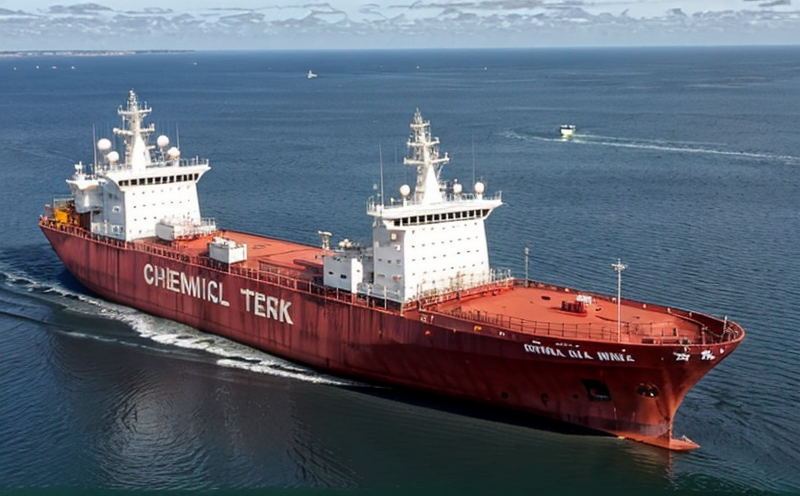Chemical tanker vessel inspection
The inspection of chemical tankers is a critical aspect of ensuring safety and compliance in the transportation and logistics sector. Chemical tankers are responsible for transporting hazardous materials, which require meticulous attention to detail during inspections to prevent accidents that could have severe environmental and health impacts.
Our laboratory specializes in providing comprehensive inspections to ensure these vessels meet all relevant international standards and regulations. The inspection process involves several key steps including initial documentation review, vessel preparation, detailed visual inspection, non-destructive testing (NDT), and comprehensive reporting. This ensures that the chemical tankers are safe for transport and comply with all legal requirements.
The primary goal of our service is to identify any potential hazards or issues that could arise during transportation. By adhering strictly to international standards such as ISO 9712, ASME Section VIII, and SOLAS (Safety of Life at Sea), we ensure that the vessels are in perfect condition for their intended use.
Our team of experts uses advanced technologies like ultrasonic testing (UT) and radiographic examination to detect any anomalies or defects within the vessel's structure. This is crucial as even small imperfections could lead to catastrophic failures, especially when transporting highly volatile chemicals.
The inspection process starts with a thorough review of the vessel’s technical documentation provided by the ship owner or operator. This includes details about previous inspections, maintenance records, and any modifications made since last certification. Following this, we conduct a detailed visual inspection which involves checking for signs of corrosion, wear and tear, and other visible damage.
Non-destructive testing (NDT) is then performed using various techniques depending on the specific requirements of each vessel. These tests include ultrasonic testing to check thickness variations in the hull plates, magnetic particle testing for detecting surface cracks, and radiographic examination for internal defects. Each technique provides valuable insights into the structural integrity and condition of the vessel.
Once all inspections are complete, our team generates a detailed report summarizing findings from both visual inspections and NDT results. This report serves as evidence that the vessel has passed rigorous checks and meets all necessary safety standards. It also includes recommendations for further maintenance or repairs if any issues were identified during the inspection process.
The importance of chemical tanker vessel inspection cannot be overstated given its role in safeguarding human life, marine ecosystems, and infrastructure along coastlines worldwide. Our laboratory’s commitment to excellence ensures that every aspect of this critical service is handled with precision and professionalism.
Applied Standards
| Standard | Description |
|---|---|
| ISO 9712 | International standard for non-destructive testing (NDT). |
| ASME Section VIII | American Society of Mechanical Engineers’ code for pressure vessels. |
| SOLAS | International Convention for the Safety of Life at Sea, which sets international safety standards for ships. |
| IEC 62450-1 | International Electrotechnical Commission’s standard for ultrasonic testing methods. |
| EN ISO 3834 | European Union harmonized standard for welding work. |
| ASTM E1316 | American Society for Testing and Materials’ standard practice for radiographic examination of fusion welds in the pipeline industries. |
| API 579-1/AI 579-1 | American Petroleum Institute’s guideline for fitness-for-service evaluation of pressure-containing equipment. |
The inspection process adheres strictly to these international standards, ensuring that all chemical tanker vessels meet the highest levels of safety and reliability. Compliance with these standards guarantees that our inspections are both accurate and consistent across different regions and countries.
International Acceptance and Recognition
The results from our comprehensive inspection services for chemical tankers are widely recognized internationally, providing peace of mind to shipping companies operating in multiple jurisdictions. Our laboratory’s certifications and accreditations allow us to provide inspections that meet the requirements set by various regulatory bodies around the world.
By adhering to international standards such as ISO 9712, ASME Section VIII, and SOLAS (Safety of Life at Sea), we ensure that our services are accepted not only in major shipping hubs like Rotterdam, Singapore, and New York but also across smaller ports where compliance with these standards is essential.
Our laboratory has earned a reputation for delivering reliable and accurate chemical tanker inspections, which have been validated by numerous global organizations. This recognition underscores the quality of our services and reinforces trust among clients operating in diverse markets.
Use Cases and Application Examples
The use cases for chemical tanker vessel inspection are vast, ranging from routine maintenance checks to pre-shipment certifications required by international shipping regulations. Here are some examples:
Routine inspections: Regular checks performed every 5 years or after major modifications.
New build inspections: Ensuring newly constructed tankers comply with all safety and environmental standards before entering service.
Maintenance planning: Identifying areas needing repair or replacement to optimize operational efficiency and extend vessel lifespan.
Pre-shipment certifications: Providing documentation required by international shipping regulations for transporting hazardous chemicals safely.
In addition to these applications, our laboratory also offers specialized services tailored to specific needs such as emergency inspections following accidents or incidents involving chemical tankers.





